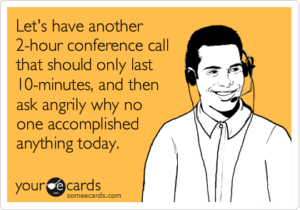or maybe it’s just on conference calls. I believe strongly in remote work, and by extension I believe in asynchronous communication like email and chat apps, but also believe we need real-time communication like phone calls, conference calls or web sharing sessions. However, I am still amazed by how people behave on conference calls. It seems as if people just lose a little bit of themselves, and forget common courtesies. Today I’m going to use my soapbox to discuss some of my bigger pet peaves.
- Remember everyone on the conference call, not just those in the room. As a project manager, I try to be conscious of everyone on the call. This includes multiple people that might be in the same room or that person sitting alone. There have been times where I’ve been the only decision maker participating by conference call. During these times, I feIt I had to time my opportunity to speak up just right. I had to do this by jumping in on any pause, regardless of where the discussion was at the time. Alternatively, I will often have side conversations via text to facilitate progress. For people in the same room, or for the conference call organizer, it is important to remember to intentionally include all participates. You invited them for a reason.
- Someone needs to lead the call. The belief that conference calls aren’t effective speaks more to the organization of the call, than anything else. There is always a reason a conference call gets scheduled. Someone needs to facilitate the call. What are you trying to accomplish? What is the take away? And most helpful, if something needs to be prepared or investigated beforehand, make sure that expectation was set when the call was scheduled. Otherwise you are wasting everyone’s time.
- Don’t forget your manners. I guess all my frustration really boils down to this. I want to believe that we are all passionate human beings and sometimes tempers flair. I know that’s happened to me. We can only control our own behavior so let’s try to reign in our tempers and remember we are all there, in that moment, for a common good.







